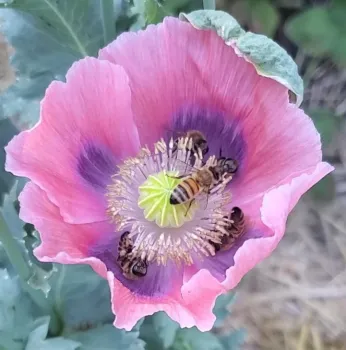
This series provides answers to selected questions recently submitted to the UC Master Gardeners of Yolo County Help Desk.
Question: I would like advice on the most pollinator-safe herbicides and insecticides to use and how best to use them.
Answer: Although most insects are useful for something, including food for animals or other insects, and it’s been said that weeds are simply plants that are growing in places where we don’t want them to grow, for the purposes of this answer we’ll call unwanted insects and weeds “pests.”
The University of California Master Gardener Program promotes “Integrated Pest Management (IPM).” This strategy “encourages methods that provide long-term prevention or suppression of pest problems with minimum impact on human health, the environment, and nontarget organisms.” IPM utilizes three basic methods for controlling pests: mechanical, biological, and chemical, with chemical controls usually considered a last resort. The University has created an extensive web site to provide information on IPM approaches for specific pest problems. https://ipm.ucanr.edu.
For example: If you have a plant infested with aphids, the mechanical method of control could involve removing the pests by hand or spraying them off with water. The biological method could involve attracting or otherwise introducing beneficial insects, such as ladybugs, which prey on aphids. The chemical method would be the use of a store-bought insecticide.
You specifically mention pollinators, which include butterflies and bees. With the honeybee colonies in the United States projected, according to entomologists at Washington State University, to decline at least seventy percent this year, it’s certainly important to consider the negative effects that herbicides and insecticides could have on bees in general and honeybees in particular. That’s why every effort should be made to first employ mechanical and biological controls before resorting to chemicals.
In the case of weeds, mechanical controls would include diligently hand-pulling or hoeing those unwanted plants until the problem is sufficiently managed. A biological control could involve using a thick layer of mulch to suppress the weeds.
If you must resort to an herbicide, be mindful that many herbicides will also harm pollinators by removing food sources and, in many cases, killing them directly. Best practices include finding out which species of beneficial insects are in your garden and carefully reading all product labels. According to the UC IPM Program, “Methods for protecting bees and promoting pollination can differ depending on the crop and bee species.”
For insect pests, in addition to physically removing them by hand or water spray, you can use traps or physical barriers like cardboard or sticky collars around stems and trunks. It’s important to find out exactly what insect is causing the plant damage in order to determine how best to manage the problem. And, as with herbicides, make sure to read and follow all pesticide labels to ensure you’re using the appropriate product and amount for the specific pest you want to control, while at the same time minimizing any negative impact on pollinators.
For several reasons, the UC Master Gardener Program does not recommend or endorse any specific brand of pesticide or herbicide.
A fundamental concept of IPM “is that a certain amount of [pest damage] can be tolerated. Broad-spectrum pesticides [and herbicides] are used only as a last resort…. An IPM program can be carried out in most garden situations with almost no use of pesticides [or herbicides] that are more toxic than fungicidal and insecticidal soaps, horticultural oils, or microbials.”
For more information: https://xerces.org/blog/protect-pollinators-at-home-alternatives-to-herbicides
This article previously appeared in the Winters Express and Davis Enterprise.
If you have a gardening question, contact the UC Master Gardener Help Desk at 530-666-8737. Or send an email, with information regarding watering, sun exposure, details about your problem, and photos when possible.

